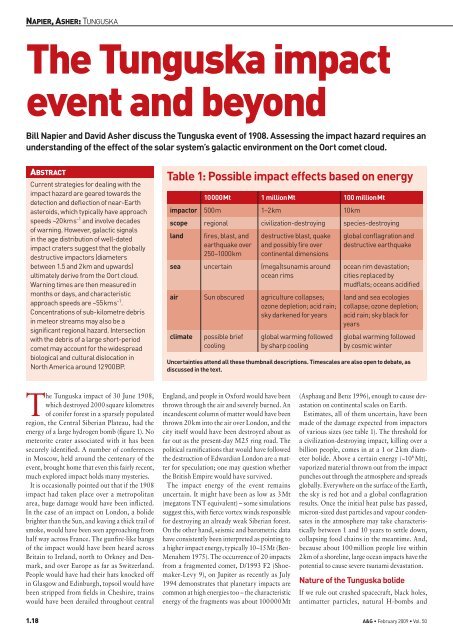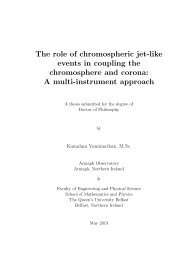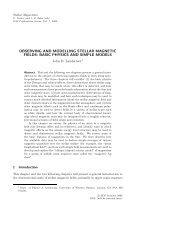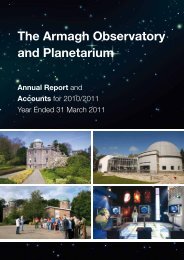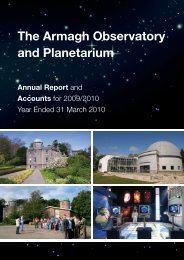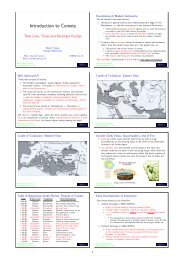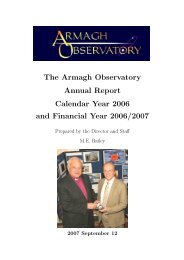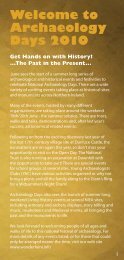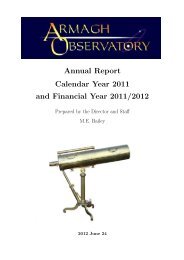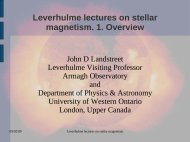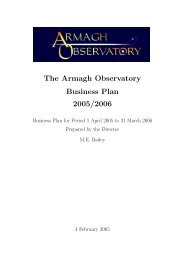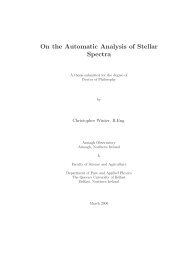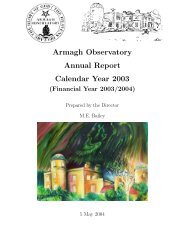The Tunguska Impact Event and Beyond - PDF - Armagh Observatory
The Tunguska Impact Event and Beyond - PDF - Armagh Observatory
The Tunguska Impact Event and Beyond - PDF - Armagh Observatory
You also want an ePaper? Increase the reach of your titles
YUMPU automatically turns print PDFs into web optimized ePapers that Google loves.
NAPIER, ASHER: TUNGUSKA<br />
<strong>The</strong> <strong>Tunguska</strong> impact<br />
event <strong>and</strong> beyond<br />
Bill Napier <strong>and</strong> David Asher discuss the <strong>Tunguska</strong> event of 1908. Assessing the impact hazard requires an<br />
underst<strong>and</strong>ing of the effect of the solar system’s galactic environment on the Oort comet cloud.<br />
ABSTRACT<br />
Current strategies for dealing with the<br />
impact hazard are geared towards the<br />
detection <strong>and</strong> deflection of near-Earth<br />
asteroids, which typically have approach<br />
speeds ~20 km s –1 <strong>and</strong> involve decades<br />
of warning. However, galactic signals<br />
in the age distribution of well-dated<br />
impact craters suggest that the globally<br />
destructive impactors (diameters<br />
between 1.5 <strong>and</strong> 2 km <strong>and</strong> upwards)<br />
ultimately derive from the Oort cloud.<br />
Warning times are then measured in<br />
months or days, <strong>and</strong> characteristic<br />
approach speeds are ~55 km s –1 .<br />
Concentrations of sub-kilometre debris<br />
in meteor streams may also be a<br />
significant regional hazard. Intersection<br />
with the debris of a large short-period<br />
comet may account for the widespread<br />
biological <strong>and</strong> cultural dislocation in<br />
North America around 12 900 BP.<br />
Table 1: Possible impact effects based on energy<br />
10 000 Mt 1 million Mt 100 million Mt<br />
impactor 500 m 1–2 km 10 km<br />
scope regional civilization-destroying species-destroying<br />
l<strong>and</strong><br />
fires, blast, <strong>and</strong><br />
earthquake over<br />
250–1000 km<br />
destructive blast, quake<br />
<strong>and</strong> possibly fire over<br />
continental dimensions<br />
sea uncertain (mega)tsunamis around<br />
ocean rims<br />
air Sun obscured agriculture collapses;<br />
ozone depletion; acid rain;<br />
sky darkened for years<br />
climate<br />
possible brief<br />
cooling<br />
global warming followed<br />
by sharp cooling<br />
global conflagration <strong>and</strong><br />
destructive earthquake<br />
ocean rim devastation;<br />
cities replaced by<br />
mudflats; oceans acidified<br />
l<strong>and</strong> <strong>and</strong> sea ecologies<br />
collapse; ozone depletion;<br />
acid rain; sky black for<br />
years<br />
global warming followed<br />
by cosmic winter<br />
Uncertainties attend all these thumbnail descriptions. Timescales are also open to debate, as<br />
discussed in the text.<br />
<strong>The</strong> <strong>Tunguska</strong> impact of 30 June 1908,<br />
which destroyed 2000 square kilometres<br />
of conifer forest in a sparsely populated<br />
region, the Central Siberian Plateau, had the<br />
energy of a large hydrogen bomb (figure 1). No<br />
meteorite crater associated with it has been<br />
securely identified. A number of conferences<br />
in Moscow, held around the centenary of the<br />
event, brought home that even this fairly recent,<br />
much explored impact holds many mysteries.<br />
It is occasionally pointed out that if the 1908<br />
impact had taken place over a metropolitan<br />
area, huge damage would have been inflicted.<br />
In the case of an impact on London, a bolide<br />
brighter than the Sun, <strong>and</strong> leaving a thick trail of<br />
smoke, would have been seen approaching from<br />
half way across France. <strong>The</strong> gunfire-like bangs<br />
of the impact would have been heard across<br />
Britain to Irel<strong>and</strong>, north to Orkney <strong>and</strong> Denmark,<br />
<strong>and</strong> over Europe as far as Switzerl<strong>and</strong>.<br />
People would have had their hats knocked off<br />
in Glasgow <strong>and</strong> Edinburgh, topsoil would have<br />
been stripped from fields in Cheshire, trains<br />
would have been derailed throughout central<br />
Engl<strong>and</strong>, <strong>and</strong> people in Oxford would have been<br />
thrown through the air <strong>and</strong> severely burned. An<br />
inc<strong>and</strong>escent column of matter would have been<br />
thrown 20 km into the air over London, <strong>and</strong> the<br />
city itself would have been destroyed about as<br />
far out as the present-day M25 ring road. <strong>The</strong><br />
political ramifications that would have followed<br />
the destruction of Edwardian London are a matter<br />
for speculation; one may question whether<br />
the British Empire would have survived.<br />
<strong>The</strong> impact energy of the event remains<br />
uncertain. It might have been as low as 3 Mt<br />
(megatons TNT equivalent) – some simulations<br />
suggest this, with fierce vortex winds responsible<br />
for destroying an already weak Siberian forest.<br />
On the other h<strong>and</strong>, seismic <strong>and</strong> barometric data<br />
have consistently been interpreted as pointing to<br />
a higher impact energy, typically 10–15 Mt (Ben-<br />
Menahem 1975). <strong>The</strong> occurrence of 20 impacts<br />
from a fragmented comet, D/1993 F2 (Shoemaker-Levy<br />
9), on Jupiter as recently as July<br />
1994 demonstrates that planetary impacts are<br />
common at high energies too – the characteristic<br />
energy of the fragments was about 100 000 Mt<br />
(Asphaug <strong>and</strong> Benz 1996), enough to cause devastation<br />
on continental scales on Earth.<br />
Estimates, all of them uncertain, have been<br />
made of the damage expected from impactors<br />
of various sizes (see table 1). <strong>The</strong> threshold for<br />
a civilization-destroying impact, killing over a<br />
billion people, comes in at a 1 or 2 km diameter<br />
bolide. Above a certain energy (~10 6 Mt),<br />
vaporized material thrown out from the impact<br />
punches out through the atmosphere <strong>and</strong> spreads<br />
globally. Everywhere on the surface of the Earth,<br />
the sky is red hot <strong>and</strong> a global conflagration<br />
results. Once the initial heat pulse has passed,<br />
micron-sized dust particles <strong>and</strong> vapour condensates<br />
in the atmosphere may take characteristically<br />
between 1 <strong>and</strong> 10 years to settle down,<br />
collapsing food chains in the meantime. And,<br />
because about 100 million people live within<br />
2 km of a shoreline, large ocean impacts have the<br />
potential to cause severe tsunami devastation.<br />
Nature of the <strong>Tunguska</strong> bolide<br />
If we rule out crashed spacecraft, black holes,<br />
antimatter particles, natural H-bombs <strong>and</strong><br />
1.18 A&G • February 2009 • Vol. 50
NAPIER, ASHER: TUNGUSKA<br />
1: <strong>The</strong> explosion due to an incoming cosmic<br />
body over the <strong>Tunguska</strong> region of Siberia in<br />
1908 flattened trees over 2000 square km.<br />
geophysical explosions as causes of the <strong>Tunguska</strong><br />
impact, we are down to a comet or asteroid.<br />
In 1930, the British meteorologist F J W Whipple<br />
suggested that the <strong>Tunguska</strong> body was a<br />
small comet, <strong>and</strong> this view has generally been<br />
supported by Russian astronomers. Hughes<br />
(1976) likewise considered that the object was<br />
probably a small comet. <strong>The</strong> American astronomer<br />
Fred Whipple (1975) – not the meteorologist<br />
– thought it more likely that the bolide was<br />
an inactive, low-density, friable body. <strong>The</strong> suggestion<br />
by Kresák (1978) that the body was a<br />
fragment of the short-period comet 2P/Encke,<br />
<strong>and</strong> therefore part of the Taurid Complex, was<br />
supported by the coincidence in the date of<br />
impact (30 June) with the Earth’s annual passage<br />
through the daytime Taurids. <strong>The</strong> trajectory<br />
of the bolide moreover lies within 20°<br />
of that of the comet, a difference explicable by<br />
planetary perturbations (Asher <strong>and</strong> Steel 1998).<br />
Sekanina (1983), however, argued that a body<br />
composed of weak cometary material could<br />
not have survived intact on a journey into the<br />
lower atmosphere, <strong>and</strong> proposed instead that<br />
the object was dense <strong>and</strong> rocky, probably from<br />
the asteroid belt.<br />
Recent hydrocode simulations by both Russian<br />
<strong>and</strong> American groups revealed that, from<br />
the perspective of impact mechanics, the object<br />
could have been either cometary or asteroidal.<br />
<strong>The</strong> forward momentum of a large fireball<br />
breaking up even at high altitude can bring it<br />
close to the ground. <strong>The</strong> severe dearth of cosmic<br />
material on the ground may be due to the<br />
updraught of the fireball, which forms a rapidly<br />
rising, near-spherical plume. Debris from<br />
the plume may be spread over about 1500 km,<br />
<strong>and</strong> scattered sunlight from this debris could<br />
account for the widely reported reading of<br />
newspapers, overnight cricket, midnight photography<br />
<strong>and</strong> the like during the night of 30<br />
June 1908 in Engl<strong>and</strong>. <strong>The</strong> simulations show<br />
that the object could have been a 50–60 m<br />
diameter stony asteroid, or an 80–100 m<br />
comet: either would produce similar effects at<br />
the <strong>Tunguska</strong> site. A 70 m comet falling vertically<br />
could reach the ground, whereas one up to<br />
1 km across, coming in at 5° to the horizontal,<br />
would unload nearly all its kinetic energy into<br />
the atmosphere.<br />
An interesting debate has been stimulated as<br />
to whether there is in fact an impact crater at<br />
the site. A group in Bologna (Gasperini et al.<br />
2007) has suggested that Lake Cheko, a 300 m<br />
lake 8 km downrange from the epicentre, may<br />
be such. It is steep-sided <strong>and</strong> bowl-shaped, <strong>and</strong><br />
cone-shaped at depth. It does not seem to be a<br />
me<strong>and</strong>er lake or volcanic depression, <strong>and</strong> it is<br />
not shown on an 1883 map of the area. A seismic<br />
anomaly exists just below the bed of the lake.<br />
On the other h<strong>and</strong>, there is no evidence around<br />
the lake of high shock pressure or temperature<br />
<strong>and</strong> no sign of ejected material. Further, it seems<br />
that no trees were affected by the postulated<br />
impact even at the edge of the lake. Numerical<br />
simulations by Collins et al. (2008) have failed<br />
to reconcile these conflicting factors.<br />
Analyses of peat columns in the catastrophe<br />
layers have revealed isotopic composition shifts<br />
for carbon-13 <strong>and</strong> deuterium in addition to<br />
enhanced iridium <strong>and</strong> enriched siderophile elements.<br />
<strong>The</strong>se have been interpreted as evidence<br />
A&G • February 2009 • Vol. 50 1.19
NAPIER, ASHER: TUNGUSKA<br />
of a cometary origin for the <strong>Tunguska</strong> cosmic<br />
body (Kolesnikov <strong>and</strong> Rasmussen 2008).<br />
<strong>Impact</strong> frequencies<br />
Estimates of <strong>Tunguska</strong>-like impact frequencies<br />
have varied enormously over the years. Kresák<br />
(1978), extrapolating from fireball data, thought<br />
that such events might happen at about 50-year<br />
intervals. Hughes (1976) considered them to be<br />
once in 2000-year events on the assumption<br />
that the impactor was a small active comet, a<br />
figure which has also been derived on the basis<br />
of Spaceguard survey observations (table 2).<br />
What appear to be records of similar impacts<br />
are to be found throughout early mythological<br />
literature. Hellenistic myth, for example,<br />
includes the story of Phaethon, who borrowed<br />
the chariot of his father Helios, but was unable<br />
to control its horses as they crossed the sky,<br />
with the result that the chariot crashed to the<br />
ground in a blinding light, flattening <strong>and</strong> burning<br />
forests, poisoning rivers <strong>and</strong> darkening the<br />
sun. Various commentators over the years have<br />
regarded these <strong>and</strong> similar myths as referring to<br />
one or more real events (Plato, Goethe, Kugler,<br />
Engelhardt). Similar tales are to be found in<br />
the earliest Sanskrit literature, throughout the<br />
near East <strong>and</strong> as far away as China. <strong>The</strong> earliest<br />
recorded literature containing such material<br />
is to be found in Babylonian cosmology, going<br />
back to 2000 BC but probably based on preliterate<br />
oral traditions. Megaton-class impacts<br />
may therefore have impressed themselves from<br />
time to time on early cultures.<br />
Beginning in the 1970s, helped by satellite<br />
observations of the Earth <strong>and</strong> Schmidt telescope<br />
surveys, quantitative assessments of the<br />
impact rate became possible. One approach,<br />
then, is to extrapolate from the known impact<br />
craters on Earth, using some energy–diameter<br />
scaling relation.<br />
Many impact craters are so large that they are<br />
not easily recognized from the ground, the crater<br />
diameters extending far beyond the visible<br />
horizon (as in the case of Lake Manicouagan in<br />
Quebec, which is about 100 km across). About<br />
170 impact structures are known on Earth,<br />
with another dozen or so c<strong>and</strong>idates. <strong>The</strong>y are<br />
very unevenly distributed, being concentrated<br />
around the Baltic <strong>and</strong> Canadian Shields as well<br />
as desert areas. Throughout India, Pakistan,<br />
Tibet, China <strong>and</strong> the Far East, there is only<br />
one recorded impact crater: the Lonar Crater<br />
in central India, about 1 km across, 50 000<br />
years old <strong>and</strong> already heavily eroded – it will<br />
disappear in the blink of a geological eye.<br />
Thus the data set of terrestrial impact craters<br />
is extremely incomplete. Moreover, sub-kilometre<br />
bodies will tend to disintegrate in the<br />
atmosphere <strong>and</strong> will be underrepresented in the<br />
impact cratering record. <strong>The</strong>y may nevertheless<br />
generate damaging airbursts, <strong>and</strong> on timescales<br />
of immediate human interest may be the most<br />
Table 2: <strong>Impact</strong> frequency estimates<br />
author year entity collisions method<br />
Sekanina <strong>and</strong><br />
Yeomans<br />
Bailey <strong>and</strong><br />
Emel’yanenko<br />
1984 active comets 43 Myr (mostly ≳1 km) historic comet<br />
encounters<br />
1998 Halley-type<br />
comets<br />
Nurmi et al. 2001 captured Oort<br />
cloud comets<br />
dangerous class of impact.<br />
Estimates of the collision hazard posed by<br />
interplanetary bodies on short timescales<br />
may be arrived at in other ways. One procedure<br />
is to extrapolate the known population<br />
of near-Earth objects (NEOs) currently being<br />
revealed by several comet <strong>and</strong> asteroid search<br />
programmes (such as the Spacewatch, LINEAR<br />
<strong>and</strong> Catalina surveys). From these surveys, it is<br />
generally considered that completeness of discovery<br />
has now approached 100% for bodies<br />
>3 km in diameter, ~80% for >1 km diameter,<br />
declining rapidly to a fraction of a percent for<br />
objects around 100 m or less.<br />
A movie of the known NEOs (an animation by<br />
Scott Manley is at http://star.arm.ac.uk/neos/<br />
anim.html) would reveal that there is a brisk<br />
movement of material between the main asteroid<br />
belt <strong>and</strong> the inner planetary system. It is known<br />
furthermore that asteroids deflected from the<br />
main belt on timescales ~10 6 yr (Morbidelli<br />
1999) are a prime source of hazardous bodies.<br />
Generally missing from such movies are comets;<br />
<strong>and</strong> yet the number of NEAs (near-Earth asteroids)<br />
more than about 5 km in diameter capable<br />
of striking the Earth is tiny – at present the only<br />
bodies in Earth-crossing orbits with diameters<br />
of this order are comets. It may be that below<br />
a certain threshold, asteroids diverted from the<br />
main belt are the prime hazard, while above<br />
this, comets are dominant.<br />
By some accounts, long-period comets are<br />
“comparable with NEAs”<br />
comet dynamics<br />
1 km) comet dynamics<br />
Rickman et al. 2001 Jupiter family ~1 Myr (>1 km) comet dynamics<br />
Morbidelli et al. 2002 1000 Mt 63 000 ± 8000 yr Spaceguard<br />
Hughes 2003 1000 Mt 3000 yr close encounters<br />
with NEAs<br />
Stokes et al. 2003 LP/NEA ~1% close encounters<br />
with comets<br />
Stuart <strong>and</strong><br />
Binzel<br />
2004 10 Mt impacts 2000–3000 yr<br />
1000 Mt 56 000 ± 6000 yr<br />
Spaceguard<br />
Asher et al. 2005 10 Mt impacts
NAPIER, ASHER: TUNGUSKA<br />
N<br />
7<br />
6<br />
5<br />
4<br />
3<br />
2<br />
1<br />
o o o o o o oo o o o<br />
* * * * * * * *<br />
0<br />
0 50 100 150 200 250<br />
time (Myr)<br />
2: <strong>The</strong> age distribution of 40 impact craters 3 km or more in diameter, with ages less than 250 Myr<br />
known to precision better than 10 Myr (data smoothed in this plot by a window of width 8 Myr).<br />
<strong>Impact</strong>s occur in discrete episodes of bombardment. <strong>The</strong> circles represent the formation date<br />
for 12 craters over 40 km across with ages measured to precision 2.6 Myr or better. <strong>The</strong> asterisks<br />
mark out a best-fitting periodicity of ~35 Myr for those 12. (See figure 5.)<br />
their method of derivation <strong>and</strong> the nature of<br />
impactor or energy yield referred to. If we<br />
consider historic encounters with comets <strong>and</strong><br />
close approaches with active comets, we find<br />
comfortably long intervals between collisions.<br />
Higher impact rates tend to be estimated from<br />
considerations of the migration or evolution<br />
between various sub-populations of comets<br />
that inhabit the planetary system. <strong>The</strong> number<br />
of bodies in a reservoir, <strong>and</strong> the rate at which<br />
they are calculated to transfer between reservoirs,<br />
yield theoretical estimates of population<br />
based on the assumption of equilibrium. <strong>The</strong>se<br />
mass balance calculations lead to much higher<br />
impact estimates, typically by two powers of<br />
ten, than those obtained from direct observations<br />
of the arrival of active comets from the<br />
various reservoirs. Table 2 shows that this discrepancy<br />
holds even down to 10 Mt (<strong>Tunguska</strong>sized)<br />
impactors.<br />
If we consider close encounters of small interplanetary<br />
bodies with the Earth, which may be<br />
less subject to various modelling uncertainties,<br />
then the estimates of impact rate become substantially<br />
higher. A <strong>Tunguska</strong>-like impact then<br />
becomes something like a 300-year event, as<br />
against a 2000 or 3000-year one as deduced<br />
from Spaceguard surveys (the latter implying<br />
that such an impact a mere century ago was<br />
something of a statistical fluke). A more direct<br />
estimate comes from the three dozen or so<br />
meteorites ejected from the Moon <strong>and</strong> found in<br />
desert <strong>and</strong> Antarctic regions. Assuming that it<br />
takes a ≳10 Mt impact on the Moon to dislodge<br />
material at escape velocity with the potential to<br />
l<strong>and</strong> on Earth, <strong>and</strong> from the likeliest survival<br />
times on Earth, Asher et al. (2005) deduced a<br />
lunar impact rate which translated to <strong>Tunguska</strong><br />
impacts at
NAPIER, ASHER: TUNGUSKA<br />
phase (Myr)<br />
20<br />
15<br />
10<br />
5<br />
0<br />
–5<br />
–10<br />
–15<br />
–20<br />
20 25 30 35 40 45 50<br />
period (Myr)<br />
3: Retrieving the periodicity. <strong>The</strong> motion of the Sun around the galaxy has been simulated using<br />
galactic plane data derived from Hipparcos. <strong>The</strong> flux of comets from the Oort cloud varies pro rata<br />
with the local galactic tide <strong>and</strong> also has r<strong>and</strong>om components due to encounters with molecular<br />
clouds which exist preferentially in the galactic plane. Synthetic impact craters are extracted<br />
from the dynamical model, assuming impact probability to be proportional to the flux of comets<br />
from the Oort cloud, <strong>and</strong> taking account of the disappearance of terrestrial impact craters with<br />
time. <strong>The</strong> synthetic data are then analysed for periodicity (de-trending <strong>and</strong> applying power<br />
spectrum analysis to bootstrapped data). <strong>The</strong> inbuilt periodicity in the model is well retrieved<br />
(P 36 Myr, 2 Myr). Phase is defined as the time elapsed since the most recent episode. Other<br />
sets of harmonic solutions sometimes arise, depending on the vagaries of the r<strong>and</strong>omly selected<br />
data. In the example above a second group of solutions appears strongly, P 26 Myr, 11 Myr.<br />
Interestingly, this is a close match to the periodicity which Raup <strong>and</strong> Sepkoski (1984) claimed to<br />
exist in the extinction record of marine families.<br />
phase (Myr)<br />
20<br />
15<br />
10<br />
5<br />
0<br />
–5<br />
–10<br />
–15<br />
–20<br />
20 25 30 35 40 45 50<br />
period (Myr)<br />
4: Bootstrap analysis applied to large (D > 40 km) terrestrial impact craters. Within the range of<br />
uncertainty the most probable period <strong>and</strong> phase – (P,) (35,0) Myr – are as expected from the<br />
dynamical model, but weaker harmonic solutions are also present.<br />
Table 3: <strong>Impact</strong>s<br />
resulting from main<br />
belt asteroids<br />
family %<br />
hitting<br />
Earth<br />
episode<br />
duration<br />
(Myr)<br />
no. of<br />
>1 km<br />
impacts<br />
Flora 1.5 30 4<br />
Vesta 0.2 10 0<br />
Eunomia 0.2 10 12<br />
Gefion 0.02 5 2<br />
Dora 0.02 5 2<br />
Koronis 0.02 5 0<br />
Eos 0.007 140 2<br />
<strong>The</strong>mis 0.0026 90 3<br />
Terrestrial impacts expected from main<br />
belt asteroid disintegrations over 10 8 –10 9 yr<br />
(Zappalá et al. 1998). <strong>The</strong>se generally cannot<br />
reproduce the sharpness <strong>and</strong> amplitude of<br />
the observed bombardment episodes.<br />
so-called Damocloids, have been found so far.<br />
Thirdly, the comets may develop super-dark<br />
mantles, with albedos p < 0.01 (Napier et al.<br />
2004). This is possible if the comet nucleus<br />
becomes covered with organic grains ~10 –5 cm<br />
comprising a bird’s nest structure with porosity<br />
~0.7 or more, consistent with that observed in<br />
Brownlee particles of probable cometary origin.<br />
If sublimation of ices leaves such a structure,<br />
then vanishingly small albedos become possible.<br />
<strong>The</strong> nucleus of Comet 19P/Borrelly has<br />
developed patches of albedo ~0.008, blacker<br />
than anything on Earth outside of nanoengineered<br />
surfaces, <strong>and</strong> if the entire nucleus<br />
became this dark we would probably not know<br />
that the comet existed. However, nearly all HT<br />
comets would have to become this dark for the<br />
problem to be solved. We do not yet know<br />
whether this happens.<br />
<strong>The</strong> exact nature of the hazard due to this<br />
cometary material captured to HT orbits<br />
from the Oort cloud depends on the size of<br />
the individual bodies or fragments where the<br />
mass is predominantly hidden. For a r<strong>and</strong>omly<br />
distributed population of N high-eccentricity<br />
bodies with orbital periods P years, the mean<br />
interval between collisions with the Earth is<br />
t 330 P/N Myr. For a population of N = 3000<br />
dark bodies in HT orbits with P= 60 yr, the<br />
current impact interval is then t 7 Myr.<br />
<strong>The</strong> long-term interval between such speciesdestroying<br />
impacts may be 30–60 Myr, but as<br />
we are currently immersed in an impact episode<br />
(figure 2), this temporarily high rate appears to<br />
1.22 A&G • February 2009 • Vol. 50
NAPIER, ASHER: TUNGUSKA<br />
power<br />
2<br />
1.8<br />
1.6<br />
1.4<br />
1.2<br />
1<br />
0.8<br />
0.6<br />
0.4<br />
0.2<br />
0<br />
20 25 30 35 40 45 50<br />
period (Myr)<br />
be compatible with the cratering record.<br />
Hierarchic disintegration is a common mode<br />
of comet decay, <strong>and</strong> fragments that would make<br />
<strong>Tunguska</strong>-sized projectiles are a common product<br />
of these break-ups (such as in the Kreutz<br />
sungrazing family, just one example of a split<br />
comet). Such bodies, if dormant, would largely<br />
avoid telescopic detection. Could the fading<br />
problem be resolved by assuming that comets<br />
disintegrate into unseen <strong>Tunguska</strong>-sized objects<br />
with physical lifetimes in excess of their dynamical<br />
ones While it is plausible that such bodies<br />
are produced, wholesale conversion of cometary<br />
mass to such bodies would yield <strong>Tunguska</strong>-like<br />
impacts at ~10 yr intervals.<br />
<strong>The</strong> era of wide-area automated surveys has<br />
been under way for only about 10 years. If we<br />
are to extrapolate from such a short time base to<br />
impact probabilities at the 10 –3 –10 –6 per annum<br />
level, then statistical completeness becomes an<br />
issue: that is, we have to ask whether all significant<br />
types of hazard have manifested themselves<br />
over this period. <strong>The</strong> sporadic nature of<br />
comet disintegration, for example, is a potential<br />
source of failure of the “statistical completeness”<br />
assumption. Such disintegrations are<br />
not uncommon <strong>and</strong> may yield scores – <strong>and</strong> in<br />
extreme cases perhaps thous<strong>and</strong>s – of sub-km<br />
fragments. <strong>The</strong>se fragments may or may not<br />
be short-lived, but it is clearly necessary to see<br />
whether such events comprise a significant,<br />
<strong>and</strong> perhaps even dominant, impact hazard on<br />
timescales of interest to civilization. Otherwise<br />
we might be monitoring a swarm of bees while<br />
D>40km<br />
D40 km in diameter, but little or none for smaller craters. <strong>The</strong> interpretation<br />
is that impacting bodies 1.5–2 km across are comets – active or dormant – but that smaller craters<br />
are predominantly formed by impacting asteroids.<br />
st<strong>and</strong>ing on a railway line with an express train<br />
due! <strong>The</strong> surveys themselves cannot answer<br />
questions about their own statistical completeness:<br />
we have to take a broader perspective.<br />
It seems fair to say that, until we underst<strong>and</strong><br />
the fading problem, it would be unsafe<br />
to assume that the population of dark objects<br />
constitutes a negligible impact hazard at any<br />
energy level.<br />
Signatures in cratering record<br />
A quite different approach to the dark comet<br />
problem, which avoids the uncertainties involved<br />
in the fading function, is to look for galactic<br />
signatures in the impact cratering record. Since<br />
the main asteroid belt is impervious to galactic<br />
perturbations, any such signatures would be<br />
diagnostic of cometary impacts.<br />
<strong>The</strong> Oort Cloud comprises ~5 10 11 comets<br />
(down to 1 km diameter) with aphelia in the<br />
range 3000–100 000 AU. <strong>The</strong> long-period<br />
comets in the cloud are only just bound to<br />
the solar system <strong>and</strong> so are sensitive to galactic<br />
disturbances. <strong>The</strong>se arise primarily from<br />
encounters with nebulae, <strong>and</strong> from a variable,<br />
periodic galactic tide coming from the vertical<br />
motion of the solar system as it bobs up <strong>and</strong><br />
down in its orbit around the galaxy. About a<br />
third of the mass of the galaxy is in the form<br />
of nebulae, with cold, dense molecular clouds;<br />
although encounters with these nebulae have a<br />
strong sporadic component, they do tend to concentrate<br />
near the galactic plane (Z 50–60 pc).<br />
<strong>The</strong> influx of comets to the planetary system<br />
varies pro rata with the galactic tide T, which<br />
is in turn proportional to the ambient density<br />
(z) of disc material at the vertical distance z<br />
from the galactic plane: thus T –4G(z).<br />
<strong>The</strong> flux of comets from the Oort cloud may be<br />
modelled by adopting a combination of variable<br />
tide <strong>and</strong> sporadic encounters with nebulae.<br />
Long-period comets feed into other comet<br />
reservoirs (Biryukov 2007, Emel’yanenko et al.<br />
2007) <strong>and</strong> so the overall comet impact rate on<br />
Earth will reflect the ambient galactic forces<br />
acting on the Oort cloud. Here we adopt a mean<br />
in-plane density 0.15 M ⊙ pc –3 <strong>and</strong> a molecular<br />
cloud density which declines exponentially with<br />
scale height 60 pc (Wickramasinghe <strong>and</strong> Napier<br />
2008). This yields a predicted cometary flux of<br />
amplitude a few with periodicity P ~ 36 Myr.<br />
Since we passed through the galactic plane only<br />
one or two million years ago, we should be in<br />
or just past the peak of an impact episode now.<br />
Extracting crater ages r<strong>and</strong>omly from this flux,<br />
we find that the inbuilt periodicity of the model<br />
may be recovered from these synthetic datasets<br />
using st<strong>and</strong>ard procedures of power spectrum<br />
analysis (figure 3).<br />
Examination of the 40 well-dated impact<br />
structures ( < 10 Myr) of the past 250 million<br />
years reveals that the larger craters (say ≳40 km<br />
in diameter) in particular were formed in sharp,<br />
discrete, statistically significant episodes (figure<br />
2 <strong>and</strong> Napier 2006) interspersed by long, quiet<br />
intervals. <strong>The</strong>se episodes are too frequent <strong>and</strong><br />
too strong to have come from the breakup of<br />
main belt asteroids (table 3). If we now apply<br />
the periodicity-hunting procedure to those 40<br />
craters, a periodicity around 35 Myr emerges,<br />
close to that predicted from the model (figure<br />
4). <strong>The</strong> phase is also close to zero, consistently<br />
with our recent passage through the galactic<br />
plane <strong>and</strong> implying that we are currently in a<br />
higher than average period of risk.<br />
If we now divide up the craters by size, we<br />
find that the periodicity is strongly concentrated<br />
in craters more than about 30–40 km in diameter,<br />
whereas smaller ones show little sign of<br />
galactic modulation (figure 5). <strong>The</strong> break-even<br />
point of 30–40 km corresponds to impactors of<br />
between 1.5 <strong>and</strong> 2 km diameter. This is around<br />
the threshold for global catastrophe, in which<br />
one contemplates the destruction of a quarter of<br />
mankind by the impact. It seems that below this<br />
size, the main impactors are probably asteroids,<br />
whereas above it, comets dominate the record.<br />
Hence comets, active or dormant, seem to be a<br />
major global hazard.<br />
Major airbursts of the 20th century<br />
Recent estimates based on Spaceguard discoveries<br />
have suggested a deficiency in relation to<br />
downward extrapolation of the larger objects.<br />
This can be understood at a qualitative level,<br />
since the Yarkovsky effect (a thermal effect due<br />
to solar heating) will tend to hinder the effects<br />
A&G • February 2009 • Vol. 50 1.23
NAPIER, ASHER: TUNGUSKA<br />
6: Chance alignment (Left): Representative orbits of meteor sub-streams in the Taurid Complex; orbital elements taken from Kronk (1988).<br />
(Right): Large NEAs (orbits from the IAU Minor Planet Center) selected only on the basis of orbital size, shape <strong>and</strong> inclination being similar to Taurid<br />
meteors. Orbits of Earth <strong>and</strong> Jupiter also shown. Do the NEA orbits have any tendency to cluster in longitude around the TC meteors<br />
of resonances which drive asteroids out of the<br />
main belt. <strong>The</strong> sub-kilometre population is<br />
almost completely unknown, <strong>and</strong> yet airbursts<br />
from such bodies may be the most dangerous<br />
of impact phenomena for civilization. We can,<br />
however, glean something from three significant<br />
airbursts known to have occurred in the 20th<br />
century (Steel 1995).<br />
One such took place around eight o’clock in<br />
the morning of 13 August 1930, in the neighbourhood<br />
of the River Curuça in the Brazilian<br />
Amazon. <strong>The</strong> associated energy is uncertain but<br />
may have been in the range 0.2–2 Mt. Another<br />
took place on the evening of 11 December 1935,<br />
this time in British Guiana (now Guyana). Even<br />
less is known of the energy of this impact, but a<br />
local pilot reported seeing an elongated area of<br />
destroyed forest more than 20 miles across. And<br />
of course there is the <strong>Tunguska</strong> impact itself. All<br />
three occurred when the Earth passed through<br />
or close to a major meteor stream (table 4).<br />
<strong>The</strong> occurrence of three airbursts – that we<br />
know about – in the 20th century, each of which<br />
had the potential to cause huge damage, does<br />
imply that our increasingly crowded planet faces<br />
a significant level of risk from sub-kilometre<br />
bodies imbedded in meteor streams (table 5).<br />
A large Holocene short-period comet<br />
<strong>The</strong> evidence for a large comet in a short-period,<br />
low-inclination orbit, <strong>and</strong> continuously disintegrating<br />
over the last ~10 4 –10 5 yr, includes the<br />
fact that current replenishing sources are about<br />
two powers of ten inadequate to yield the mass<br />
of the zodiacal cloud (Whipple 1967, Hughes<br />
1996). Since the lifetime of the zodiacal cloud<br />
against collisional grinding <strong>and</strong> radiative effects<br />
is ~10 4 yr, an injection of ~10 19 g of dust has been<br />
Table 4: Airbursts <strong>and</strong> meteor streams<br />
airburst date meteor stream peak<br />
<strong>Tunguska</strong> River 30 June 1908 Taurids 30 June<br />
Curuça River 13 August 1930 Perseids 12 August<br />
British Guiana 11 December 1935 Geminids 13 December<br />
Coincidence <strong>The</strong> three greatest known airbursts of the 20th century all occurred when the Earth<br />
was passing through major meteor streams.<br />
required, more if the injection took place more<br />
remotely in time. A comet of mass, say, 5 10 19 g<br />
with the density of water has diameter ~50 km.<br />
Chiron-sized (≳100 km across) cometary bodies,<br />
having mass a hundred times that of the<br />
entire current NEA system, may be injected<br />
into short-period, Earth-crossing orbits with<br />
recurrence time of around 100 000 yr (Bailey et<br />
al. 1994). Thus the capture of such large comets<br />
to the inner planetary system does happen.<br />
But how high a lower bound can we put on the<br />
diameter of this Holocene comet, based on what<br />
is now observed to remain of it<br />
<strong>The</strong> Taurid Complex (TC) – a low-inclination,<br />
broad meteor stream spread over 120°<br />
of sky – fits the picture of this large comet’s<br />
remnant debris stream. Not only the Northern<br />
<strong>and</strong> Southern Taurids, but several other meteor<br />
showers such as the Northern <strong>and</strong> Southern<br />
Orionids (Babadzhanov <strong>and</strong> Obrubov 1992),<br />
are genetically related components of this complex<br />
which derives from a single parent object.<br />
<strong>The</strong> existence of northern <strong>and</strong> southern shower<br />
branches, which need 10 4 yr to develop separately,<br />
confirms the TC’s age.<br />
<strong>The</strong> present-day active comet known in the<br />
TC is 2P/Encke. This comet or its progenitor<br />
(there are no records of Encke itself before 1786)<br />
has been feeding meteoroidal material into the<br />
TC for at least a few 10 4 yr. Over this timescale<br />
this material both undergoes collisions (Steel<br />
<strong>and</strong> Elford 1986) as well as being dispersed<br />
by gravitational <strong>and</strong> radiative effects, eventually<br />
reaching the zodiacal cloud via a broad,<br />
sporadic stream (Stohl 1986) surrounding the<br />
Taurids. <strong>The</strong> sporadic stream produces the well<br />
known helion (HE) <strong>and</strong> antihelion (AH) sources<br />
seen in radar meteor data (Taylor <strong>and</strong> Elford<br />
1998, Campbell-Brown 2008). Wiegert et al.<br />
(2008) found Encke to be by far the dominant<br />
contributor to the HE <strong>and</strong> AH flux.<br />
<strong>The</strong> diameter of Encke is ~5 km (Fernández et<br />
al. 2000), while the total mass in the TC – in 1 m<br />
<strong>and</strong> smaller meteoroids alone – can be shown<br />
from meteor observations combined with stream<br />
modelling to be somewhat more than this. <strong>The</strong>se<br />
reasons imply a minimum 10 km diameter progenitor,<br />
while to satisfy the mass balance of the<br />
zodiacal cloud, <strong>and</strong> noting the absence of other<br />
obvious c<strong>and</strong>idates in the past 10 5 yr, at least,<br />
1.24 A&G • February 2009 • Vol. 50
NAPIER, ASHER: TUNGUSKA<br />
3<br />
700<br />
2.5<br />
600<br />
count<br />
2<br />
1.5<br />
1<br />
0.5<br />
count<br />
500<br />
400<br />
300<br />
200<br />
100<br />
0<br />
0 50 100 150 200 250 300 350 400<br />
longitude of perihelion (deg)<br />
0<br />
40 60 80 100 120 140<br />
longitude of perihelion (deg)<br />
7 (left): Among brighter NEAs (H < 16.5) we extract the 15 objects with semi-major axis a from 1.85–2.7 AU, eccentricity e from 0.65–1.0 <strong>and</strong> inclination i<br />
from 0–14°. <strong>The</strong>se are distributed as shown, with a mean absolute difference of 48° from Comet Encke’s longitude of perihelion ϖ which is 161°.<br />
(Right): If ϖ is uniformly r<strong>and</strong>om around 360°, the mean difference from Encke should be 90°. This Monte Carlo simulation (20 000 trials) indicates that<br />
a difference as small as 48° arises by chance only once in 2000 trials.<br />
say, 30 km is required. A similarly substantial<br />
original size may also follow depending on<br />
the amount of mass in larger bodies, through<br />
<strong>Tunguska</strong>s up to possible NEAs comparable to<br />
Encke. Are these macroscopic bodies present<br />
Taurid NEAs<br />
When the set of discovered NEAs started to<br />
grow as a result of modern surveys, at Palomar<br />
<strong>and</strong> later elsewhere, it became possible to verify<br />
the expectation that inert bodies of significant<br />
size should exist in orbits similar to the comet<br />
Encke meteor stream (Clube <strong>and</strong> Napier 1984).<br />
Subsequent papers, as the NEA catalogue<br />
exp<strong>and</strong>ed, identified further objects aligned<br />
with Encke <strong>and</strong> the TC.<br />
Following the “reduced D-criterion” method<br />
(a formal way to define orbital similarity)<br />
described by Asher et al. (1994), but using a<br />
new, up to date NEA dataset, we illustrate the<br />
TC alignment in figure 6. Valsecchi (1999) demonstrated<br />
an interesting observational selection<br />
effect that could favour the discovery of higheccentricity,<br />
low-inclination NEAs at certain<br />
longitudes. In figure 6 we therefore restrict the<br />
NEAs to absolute magnitude H
NAPIER, ASHER: TUNGUSKA<br />
set the spacing of these intersection epochs at<br />
three millennia or so, with the next such epoch<br />
due around AD 3000. Meteors we are seeing<br />
now come from outlying parts of a very broad<br />
complex. A fair number of Taurid meteors occur<br />
at present, even from low-density regions of<br />
the stream, because the whole complex really<br />
is massive.<br />
Hierarchic disintegration <strong>and</strong> fragmentation<br />
constitute an important evolutionary route<br />
for comets (Jenniskens 2008). If large comets<br />
disintegrate hierarchically (cf. progenitors of<br />
the TC <strong>and</strong> of the Kreutz sungrazing comets),<br />
then sub-kilometre objects may concentrate in<br />
comet trails, either from recent breakup or trapping<br />
in resonances. A dramatic example of a<br />
comet splitting in recent years was Comet 73P/<br />
Schwassmann-Wachmann 3 (period ~5.4 yr). At<br />
its 1995 return at least three additional nuclei<br />
were identified, <strong>and</strong> two revolutions later at the<br />
2006 apparition the disintegration had yielded<br />
around 60 pieces. <strong>The</strong> Taurid bombardments<br />
every few millennia are likely to involve multiple<br />
<strong>Tunguska</strong> impacts.<br />
A possible Holocene cosmic impact<br />
A carbon-rich black layer, ~12 900 years old,<br />
has been identified at many sites across North<br />
America (Haynes 2008). It is closely coincident<br />
in age with the abrupt cooling known as the<br />
Younger Dryas, as well as with large-scale mammoth<br />
extinctions <strong>and</strong> “rapid human behavioural<br />
shifts”, the latter taking place over decades or<br />
less. Evidence for an extraterrestrial cause has<br />
been given by Firestone et al. (2007) in the form<br />
of a contemporaneous thin layer at numerous<br />
North American sites, containing sharp peaks<br />
of iridium-bearing magnetic grains, magnetic<br />
microspherules, nanodiamonds, fullerenes<br />
containing extraterrestrial helium, <strong>and</strong> other<br />
indicators. <strong>The</strong>y consider these to be evidence<br />
for a shower of cometary airbursts (<strong>Tunguska</strong>like<br />
<strong>and</strong> larger) producing the widespread<br />
extinctions, the abrupt climate downturn <strong>and</strong><br />
extensive biomass burning, along with abrupt<br />
cultural changes <strong>and</strong> a decline in the human<br />
population. <strong>The</strong> evidence for an extraterrestrial<br />
cause has more recently exp<strong>and</strong>ed into<br />
Greenl<strong>and</strong> <strong>and</strong> Europe (Allen, personal communication),<br />
implying a disturbance on a global<br />
rather than continental scale. We are currently<br />
running simulations to determine whether the<br />
Taurid Complex can be convincingly proposed<br />
as the cause of this event.<br />
Conclusions<br />
On the evidence of the galactic signatures in the<br />
impact cratering record of the past 250 Myr,<br />
comets down to ~2 km diameter seem to be the<br />
major contributors to the global impact hazard.<br />
Active comets may be too rare to fulfil<br />
that role, <strong>and</strong> so it seems likely that dormant<br />
bodies are the major contributors. Detection,<br />
Table 5: Guilty by association<br />
meteor stream associated body period (years) encounter speed (km/s)<br />
Taurids Comet Encke 3.3 30<br />
Perseids Comet Swift-Tuttle 120 60<br />
Geminids Phaethon 1.6 35<br />
Parents, or possibly siblings, of the 20th-century impactors. All three are in cometary orbits with<br />
high encounter speeds <strong>and</strong> short warning times.<br />
deflection <strong>and</strong> mitigation strategies have not yet<br />
been developed for this class of hazard. Rare,<br />
large comets are occasionally thrown into the<br />
inner planetary system. In terms of mass, they<br />
dominate the interplanetary environment in the<br />
course of their disintegration. <strong>The</strong>re seems to<br />
be a smoking gun, in the form of the Taurid<br />
Complex <strong>and</strong> a zodiacal cloud which is substantially<br />
overmassive in relation to known sources.<br />
Disintegrating dormant comets could provide a<br />
major fraction of the dust, but the fact that over<br />
half the mass of the sporadic meteors are in a<br />
broad stream encompassing the Taurid Complex<br />
implies that a single large comet was the major<br />
contributor. On the evidence of the three major<br />
airbursts known to have taken place in the 20th<br />
century, it seems likely that the most dangerous<br />
regional hazards – sub-kilometre impactors<br />
– tend to concentrate in meteor showers associated<br />
with this erstwhile comet <strong>and</strong> with other<br />
active comets.<br />
Claims have been made by a small ad hoc<br />
group of geoscientists, the Holocene <strong>Impact</strong><br />
Working Group (http://tsun.sscc.ru/hiwg/hiwg.<br />
htm), that impacts have been much more frequent<br />
throughout the Holocene than expected<br />
from Spaceguard surveys. It remains to be seen<br />
whether these claims will continue to hold up;<br />
but on the basis of the astronomical evidence<br />
described here, they cannot yet be excluded. ●<br />
Bill Napier is Honorary Professor at the Centre for<br />
Astrobiology, Cardiff University. David Asher is<br />
Research Fellow at <strong>Armagh</strong> <strong>Observatory</strong>.<br />
References<br />
Asher D J <strong>and</strong> Steel D I 1998 Planet. Space Sci. 46<br />
205–211.<br />
Asher D J et al. 1994 Vistas Astron. 38 1–27.<br />
Asher D J et al. 2005 <strong>Observatory</strong> 125 319.<br />
Asphaug E <strong>and</strong> Benz W 1996 Icarus 121 225–248.<br />
Babadzhanov P B <strong>and</strong> Obrubov Yu V 1992 Celest.<br />
Mech. Dyn. Astron. 54 111–127.<br />
Babadzhanov P B et al. 2008 MNRAS 386 1436–1442.<br />
Bailey M E <strong>and</strong> Emel’yanenko V V 1998 in eds M M<br />
Grady et al. Geol. Soc. Lon. Special Pub. 140 11–17.<br />
Bailey M E et al. 1994 in Gehrels T ed. Hazards Due to<br />
Comets <strong>and</strong> Asteroids (University of Arizona, Tucson) 479.<br />
Ben-Menahem A 1975 Phys. Earth Planet. Inter. 11 61.<br />
Biryukov E E 2007 Solar System Res. 41 211.<br />
Campbell-Brown M D 2008 Icarus 196 144–163.<br />
Clube S V M <strong>and</strong> Napier W M 1984 MNRAS 211<br />
953–968.<br />
Collins G S et al. 2008 Terra Nova 20 165.<br />
Emel’yanenko V V <strong>and</strong> Bailey M E 1998 MNRAS 298 212.<br />
Emel’yanenko V V et al. 2007 MNRAS 381 779.<br />
Fernández Y R et al. 2000 Icarus 147 145–160.<br />
Firestone R B et al. 2007 Proc. Nat. Acad. Sci. 104 16016.<br />
Gasperini L et al. 2007 Terra Nova 19 245–251.<br />
Haynes C V 2008 Proc. Nat. Acad. Sci. 105 6520–6525.<br />
Hughes D W 1976 Nature 259 626–627.<br />
Hughes D W 1996 QJRAS 37 593–604.<br />
Hughes D W 2003 MNRAS 338 999–1003.<br />
Jenniskens P 2006 Meteor Showers <strong>and</strong> their Parent<br />
Comets (CUP).<br />
Jenniskens P 2008 Earth Moon Planets 102 505–520.<br />
Kolesnikov E M <strong>and</strong> Rasmussen K L 2008 100 years<br />
since <strong>Tunguska</strong> phenomenon: past, present <strong>and</strong> future<br />
June 26–28, Moscow.<br />
Kresák L 1978 Bull. Astron. Inst. Czechosl. 29 129–134.<br />
Kronk G W 1988 Meteor Showers: A Descriptive Catalog<br />
(Enslow).<br />
Levison H F et al. 2002 Science 296 2212–2215.<br />
Morbidelli A 1999 Celest. Mech. Dyn. Astron. 73 39–50.<br />
Morbidelli A et al. 2002 Icarus 158 329.<br />
Napier W M 2006 MNRAS 366 977.<br />
Napier W M et al. 2004 MNRAS 355 191–195.<br />
Nurmi P et al. 2001 MNRAS 327 1367–1376.<br />
Porubčan V et al. 2006 Contrib. Astron. Obs. Skalnaté<br />
Pleso 36 103–117.<br />
Raup D M <strong>and</strong> Sepkoski J J 1984 Proc. Nat. Acad. Sci.<br />
81 801–805.<br />
Rickman H 2005 in Knežević Z <strong>and</strong> Milani A eds IAU<br />
Colloq. 197 277–288.<br />
Rickman H et al. 2001 in Marov M Ya <strong>and</strong> Rickman H<br />
eds Astrophys. Space Sci. Libr. (Kluwer, Dordrecht) 261<br />
131–142.<br />
Sekanina Z 1983 Astron. J. 88 1382–1413.<br />
Sekanina Z <strong>and</strong> Yeomans D K 1984 Astron. J. 89<br />
154–161.<br />
Steel D 1995 WGN 23 207–209.<br />
Steel D I <strong>and</strong> Elford W G 1986 MNRAS 218 185–199.<br />
Stohl J 1986 in Lagerkvist C-I et al. eds Asteroids,<br />
Comets, Meteors II (Uppsala University, Uppsala,<br />
Sweden) 565–574.<br />
Stokes G H et al. 2003 Report of the Near-Earth Object<br />
Science Definition Team (NASA Off. Space Sci. Solar<br />
System Exploration Division, Maryl<strong>and</strong>, USA) http://<br />
neo.jpl.nasa.gov/neo/neoreport030825.pdf sb04.<br />
Stuart J S <strong>and</strong> Binzel R P 2004 Icarus 170 295.<br />
Taylor A D <strong>and</strong> Elford W G 1998 Earth Planets Space<br />
50 569–575.<br />
Valsecchi G B 1999 in Svoreň J et al. eds IAU Colloq.<br />
173 353–364.<br />
Whipple F J W 1930 Q. J. R. Meteorol. Soc. 56 287.<br />
Whipple F L 1967 in Weinberg J L ed. <strong>The</strong> Zodiacal<br />
Light <strong>and</strong> the Interplanetary Medium (NASA, Washington<br />
DC) 150 409–426.<br />
Whipple F L 1975 Astron. J. 80 525.<br />
Wickramasinghe J T <strong>and</strong> Napier W M 2008 MNRAS<br />
387 153–157.<br />
Wiegert P A et al. 2008 Asteroids, Comets, Meteors<br />
July 14–18, Baltimore, paper 8166.<br />
Zappalá V et al. 1998 Icarus 134 176–179.<br />
1.26 A&G • February 2009 • Vol. 50


